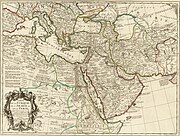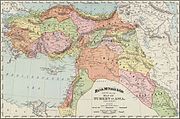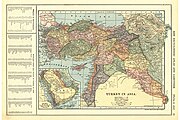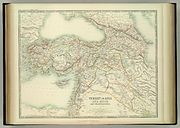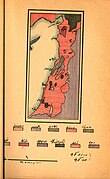Ottoman Syria
You can help expand this article with text translated from the corresponding article in Arabic. Click [show] for important translation instructions.
|
| Ottoman Syria | |||||||||||||
|---|---|---|---|---|---|---|---|---|---|---|---|---|---|
| Region of the Ottoman Empire | |||||||||||||
| 1516–1831 1841–1918 | |||||||||||||
 Ottoman territories which correspond with the Syrian provinces are shown in purple | |||||||||||||
| Capital | Administered from Istanbul | ||||||||||||
| Area | |||||||||||||
| • Coordinates | 34°N 37°E / 34°N 37°E | ||||||||||||
| • Type | Monarchy | ||||||||||||
| History | |||||||||||||
| 1516 | |||||||||||||
| 1831–1833 | |||||||||||||
| 1839–1841 | |||||||||||||
| 1918 | |||||||||||||
| |||||||||||||
Ottoman Syria (
Ottoman Syria became organized by the Ottomans upon conquest from the
History


Before 1516, Syria was part of the
Administrative divisions
When he first seized Syria in 1516, Selim I kept the administrative subdivisions of the Mamluk period unchanged. After he came back from Egypt in July 1517, he reorganized Syria into one large province or
1549–1663
In 1549, Syria was reorganized into two eyalets. The northern Sanjak of Aleppo became the center of the new Eyalet of Aleppo. At this time, the two Syrian Eyalets were subdivided as follows:
- The Arabic: إيالة حلب)
- The Sanjak of Aleppo(حلب)
- The Sanjak of Adana (أضنة)
- The Sanjak of Marash(مرعش))
- The Sanjak of Aintab(عينتاب)
- The Sanjak of Birejik (البيرة) (Urfa(أورفة))
- The Sanjak of Kilis (كلز)
- The Sanjak of Ma'arra(معرة النعمان)
- The Sanjak of Hama(حماة)
- The Sanjak of Salamiyah (سلمية)
- The Sanjak of Homs(حمص)
- The
- The Arabic: إيالة دمشق)
- The Sanjak of Damascus (دمشق)
- The Sanjak of Tripoli(طرابلس)
- The Sanjak of Acre (عكا)
- The Sanjak of Safad(صفد)
- The Sanjak of Nablus(نابلس)
- The Sanjak of Jerusalem(القدس)
- The Sanjak of Lajjun (اللجون)
- The Sanjak of Salt(السلط)
- The Sanjak of Gaza(غزة)
In 1579, the

The
The
The
.In 1660, the
1831–1841
In 1833, the Syrian provinces were ceded to
In this period, the Sublime Porte's firmans (decrees) of 1839 and, more decisively, of 1856 – equalizing the status of Muslim and non-Muslim subjects – produced a
"dramatic alienation of Muslims from Christians. The former resented the implied loss of superiority and recurrently assaulted and massacred Christian communities – in Aleppo in 1850, in Nablus in 1856, and in Damascus and Lebanon in 1860. Among the long-term consequences of these bitter internecine conflicts were the emergence of a Christian-dominated Lebanon in the 1920s – 40s and the deep fissure between Christian and Muslim Palestinian Arabs as they confronted the Zionist influx after World War I. "[3]
1861
Following the massacre of thousands of Christian civilians during the
1864
As part of the Tanzimat reforms, an Ottoman law passed in 1864 provided for a standard provincial administration throughout the empire with the eyalets becoming smaller vilayets, governed by a vali (governor) still appointed by the Sublime Porte but with new provincial assemblies participating in administration.

1872–1918
In 1872 Jerusalem and the surrounding towns became the Mutasarrifate of Jerusalem, gaining a special administrative status.
From 1872 until World War I subdivisions of Ottoman Syria were:
- Arabic: ولاية حلب)
- Arabic: سنجق دير الزور)
- Arabic: ولاية بيروت)
- Arabic: ولاية سورية)
- Arabic: متصرفية جبل لبنان)
- Arabic: متصرفية القدس الشريف)
- Arabic: متصرفية الكرك)
The sanjak Zor and the major part of the vilayet Aleppo may or may not be included in Ottoman Syria. The Geographical Dictionary of the World, published in 1906, describes Syria as:
"a country in the [south-west] part of Asia, forming part of the Turkish Empire. It extends eastward from the Mediterranean Sea to the river Euphrates and the Syrian Desert (the prolongation northward of the Arabian Desert), and southward from the Alma-Dagh (ancient Amanus), one of the ranges of the
vilayet of Syria (Suria), or of Damascus, the vilayet of Beirut, the [south-west] part of the vilayet of Aleppo, and the mutessarrifliks of Jerusalem and the Lebanon.Palestine is included in [the country] Syria, comprising the mutessarriflik of Jerusalem and part of the vilayets of Beirut and Syria.
The designation Syria is sometimes used in wider sense so as to include the whole of the vilayet of Aleppo and the Zor Sanjak, a large part of Mesopotamia being thus added."[4]
About Syria in 1915, a British report says:
"The term Syria in those days was generally used to denote the whole of geographical and historic Syria, that is to say the whole of the country lying between the Taurus Mountains and the Sinai Peninsula, which was made up of part of the Vilayet of Aleppo, the Vilayet of Bairut, the Vilayet of Syria, the Sanjaq of the Lebanon, and the Sanjaq of Jerusalem. It included that part of the country which was afterwards detached from it to form the mandated territory of Palestine."[5]
-
"Independent" Sanjak of Jerusalem shown within Ottoman administrative divisions in the Eastern Mediterranean coast after the reorganisation of 1887–88
-
Ottoman Syria until World War I. Present borders in grey.
Contemporary maps, showing Eyalets (pre-Tanzimat reforms)
-
1696 (Jaillot), showing Eyalets
-
1707
-
1740 (Seutter), showing Eyalets
-
1787 map
-
1803, from Cedid Atlas
-
1835 map by Heinrich Berghaus
-
1830 map by Sidney Hall
-
1841 Kiepert map of Palestine showing Ottoman subdivisions
-
1842, showing "Pashalics"
-
1851
Contemporary maps, showing Vilayets (post-Tanzimat reforms)
-
1855, showing sanjaks
-
1862
-
1873
-
1893
-
1896
-
1897
-
1900 (Stanford), showing Vilayets
-
1909
-
1911
-
1915 ethnographic map
-
1918, the last official Ottoman map of Palestine
See also
- Arab Kingdom of Syria
- Bilad al-Sham
- French Mandate for Syria and the Lebanon
- History of Syria
- Occupied Enemy Territory Administration
- Southern Syria
- Sykes–Picot Agreement
- Syria (Roman province)
References
- ^ The Middle East and North Africa: 2004, Routledge, page 1015: "Syria"
- ^ The Syrian Question, 1841
- ^ "Righteous Victims". archive.nytimes.com.
- ISBN 978-81-7268-012-1
- ^ Report of a Committee set up to consider certain correspondence between Sir Henry McMahon (his majesty's high commissioner in egypt) and the Sharif of Mecca in 1915 and 1916 Archived 21 June 2015 at the Wayback Machine, ANNEX A, para. 3. British Secretary of State for the Colonies, 16 maart 1939 (doc.nr. Cmd. 5974). unispal Archived 24 October 2015 at the Wayback Machine
Sources
- Bayyat, Fadil, The Ottoman State in the Arab Scope (in Arabic; 2007)
- Johann Ludwig Burckhardt, Travels in Syria and the Holy Land, Appendix II: On the Political Divisions of Syria





